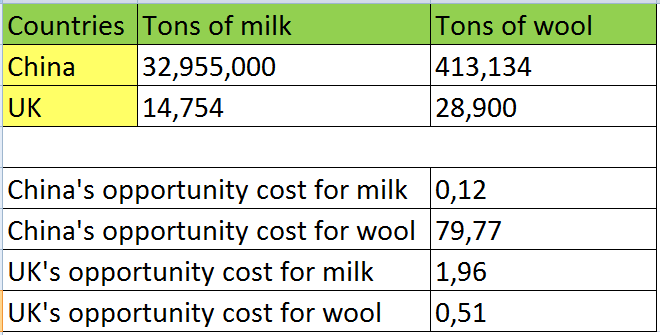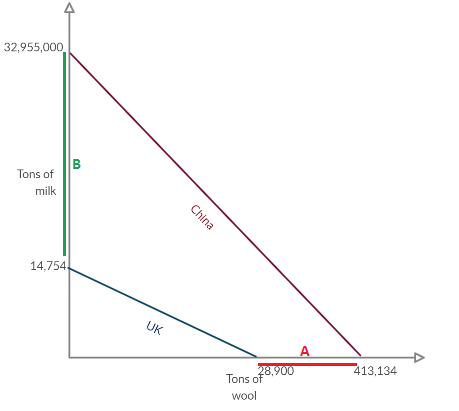Introduction
Countries vary by many socio-economic parameters, such as population density, natural resources, climate, technological advancements that allow them to specialize in various production areas. Due to specialization, some economies create an oversupply of one product category but experience the lack of another. Thus, international trade takes place when one national economy sells the things they are good at producing and purchases foreign goods.
Although some countries can have the necessary resources for producing almost any category of products, they may find that it is more profitable to import them and focus on more cost-efficient products. Such decisions are explained by comparative advantage theory that implies that “countries specialize in producing those items in which they have a comparative advantage” (Sloman and Garratt, 2013, p. 387). According to this theory, specialization and trade help countries to maximize output from the given resources of both countries and bring mutual gain. Despite its attractive formulation, comparative advantage theory has several pitfalls and is rarely manifested in real-life situations due to trade restriction policies.
Comparative Advantage Theory
The comparative advantage model was introduced by David Ricardo two centuries ago. According to Watson (2016, p. 257), the approach provides a “numerical illustration of the mutually shared gains from specialization and trade”. The understanding of absolute advantage is necessary for the comparative advantage theory. If one economy can produce an item using fewer resources than others, it has an absolute advantage over competitors.
Comparative advantage, however, can be explained through the concept of opportunity costs. This notion implies the comparison of two categories of goods within one country. The opportunity cost is the relationship between the outputs of two products with equal resources. For example, the opportunity costs of agricultural products in relation to petroleum will be high in the Middle East due to the specific distribution of natural resources. Thus, it makes sense for them to export oil, and buy fruit and vegetables from where it is cheaper to grow them.
The latter example is quite evident, but there are cases when some countries have an absolute advantage almost in everything, but international trade still makes sense. Even if a nation has no absolute advantage, it can trade those goods that require lower opportunity costs than in other countries. For example, if one economy can produce one airplane and 20 cars, and another produces ten planes and 130 cars, they can have mutual gain. Although the second country has enough resources to build automobiles and airplanes, aircraft construction is more cost-efficient for them. Given the theory of comparative advantage, their mutual output increases when they specialize. This situation is possible under the free trade conditions when prices are the drivers of the process. Without any restrictions for international trade, the manufacturers will produce and sell the most cost-efficient goods.
Illustration of Comparative Advantage Model
The example of China and UK production of wool and milk is the illustration of the situation when an absolute advantage of one country is distinct, but they still can find mutual gain. Given the population size of China, it is evident that the country’s production volumes are staggeringly different from those of the UK. The data of 2015 shows that China produced 32,955,000 tons of cow milk (National Bureau of Statistics of China, 2018).
The amount of dairy milk output in the UK during the same year equals 14,754 tons (AHDB, 2020). During 2015, China has managed to produce 413,134 tons of sheep wool, while the output of the UK comprised 28,900 tons (NBSC, 2018; SHAWG, 2016). Both parameters show the prevalence of the Chinese industries. However, the question occurs whether some categories of goods are cost-efficient or should be substituted by import. Simple calculations show that it takes a relevantly small amount of resources to produce milk in China, but the cost of wool is immense (Figure 1). If China imported wool from the UK, it could maximize its output of milk and export its surplus.

The model works both ways, revealing that the opportunity cost of milk in the UK is multiple times higher than in China, so it makes sense to import it. However, the increased import costs can be paid off from the increased production and export of wool. Interestingly, China has an absolute advantage in both, due to the availability of the workforce, but it can still maximize its benefit from specialization and trade with the UK.

The model of comparative advantage illustrates the relationships for both countries (Figure 2). The diagram shows that China has higher rates for both categories of goods, but what is most important is that the difference between amounts (A) is smaller than between milk production volumes (B). The model implies that both countries should specialize in different goods and by specification and trade they will earn more than by self-sufficiency.
The real-life situation shows that without trade restrictions prices will drive both countries to use their competitive advantage. As the milk prices have fallen since quota abolition in 2015, British milk production also decreased, which shows low cost-efficiency (Costa-Font and Revoredo-Giha, 2017). When national regulations do not protect the industry, it will be substituted by the competitors who offer lower prices, while the UK will specialize in more cost-efficient products.
Critical Analysis of Comparative Advantage
Pros of Comparative Advantage Model
The comparative advantage model is used to maximize mutual gain, and its benefits can be expressed mathematically. The primary reason to adhere to this trade approach is its potential to maximize the aggregate output of the countries without a noticeable increase in efforts and resources. The country’s involvement in free trade process that utilizes comparative advantage can leverage production capabilities and increase cost and resource efficiency. Thus, the theory looks valid because of the numerical characteristics produced by such trade.
Furthermore, the citizens of each country that regulates its import and export according to comparative advantage benefit from the reduced consumer costs (Sloman and Garrat, 2013). As both countries can produce an increased amount of goods with the same resource, it is evident that the production costs per unit will decrease. Given that there are no tariffs on international trade, the prices of these goods will drop in both countries. Moreover, the economies will have the opportunity to satisfy their difference in demand through free trade and comparative advantage. The oversupply can be imported to other countries, while the increased demand can be managed by tariff-free imports. Thus, the markets of both countries participating in such sort of trade will potentially have a win-win situation.
Cons of Comparative Advantage Model
It is assumed that free trade and specialization provide mutual gain for all the participants, but the theory fails to work in real life. Today, most countries have some restrictions, such as quotas, tariffs, or subsidies that regulate trade. There are both economic and political factors that explain the situation. First of all, refusal from the production of particular goods makes a country dependent on their trade partners, which is risky in case of political tensions. That is why most nations tend to preserve some form of self-sufficiency.
The main concern with the increased specialization and free trade is that they preserve the economic status quo on the international market and cause barriers to investments and innovations. The countries’ resources are considered as given, so often the potential of some areas is restricted by specialization. Sloman and Garratt (2013, p. 373) justify the use of protectionism for the sake of so-called ‘infant industries’ that are yet to develop their potential. Although some resources, such as population or land, are relevantly stable, the economy is still dynamic and can be influenced by technological advancements or improvements in education.
Another critical flaw with the theory is that in real life, it does not work the way it is described in Ricardo’s model. According to Baiman (2017, p. 9), comparative advantage creates an “unsustainable world economy with historically unprecedented and unimaginable levels of inequality”. The scholar believes that the model can be valid only if it is regulated adequately by the government and not ruled by market forces. However, this condition is not feasible due to the business lobbying that drives the economic decisions within countries. Thus, free trade and comparative advantages are hypothetical models that can be implemented only partially. Most of the thriving economies utilize a strategic trade approach that is a balanced solution between protectionism and free trade.
Conclusion
Comparative advantage implies that countries can maximize their aggregate output of products and increase cost-efficiency through specialization and free trade. Even the economies that have no absolute advantage can be valid trade partners due to lower opportunity costs of some goods. Although the model has several advantages, it is rarely applicable in real-life life situations. This is because it strengthens the status quo, and considers the economy as a stable environment where countries have their given resources. However, economic processes are dynamic with new industries arising regularly due to the investments and protectionism that help to reveal their potential in the long-run perspective.
Reference List
AHDB: UK monthly milk deliveries (2020). Web.
Baiman, R. (2017) The global free trade error: the infeasibility of Ricardo’s comparative advantage theory. New York: Routledge
Costa-Font, M. and Revoredo-Giha, C. (2017) ‘An empirical analysis of UK milk contract prices 2004-2016’, Agribusiness, 34(1), 112-141.
National Bureau of Statistics of China (2018) Output of Agriculture, Animal Husbandry, and Fishery. Web.
SHAWG (2016) Sheep Health and Welfare Report for Great Britain. Web.
Sloman, J. and Garratt, D. (2013) Essentials of Economics. 6th edn. Harlow, UK: Pearson.
Watson, M. (2016) ‘Historicising Ricardo’s comparative advantage theory, challenging the normative foundations of liberal international political economy’, New Political Economy, 22 (3), 257-272.